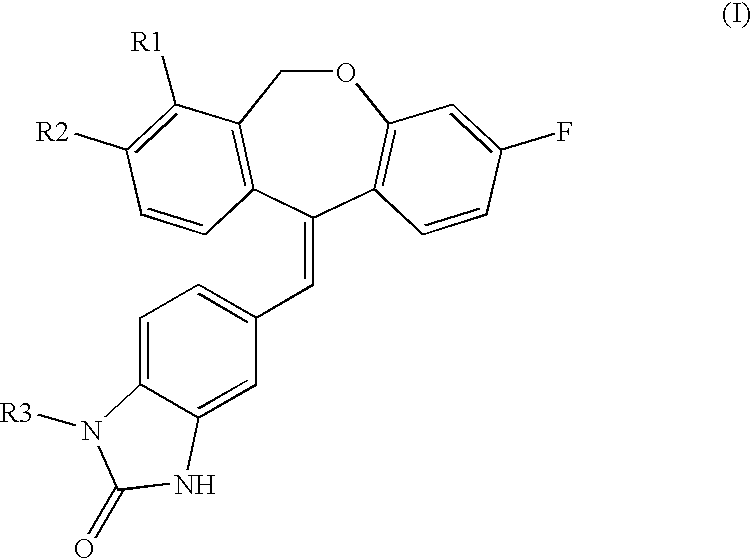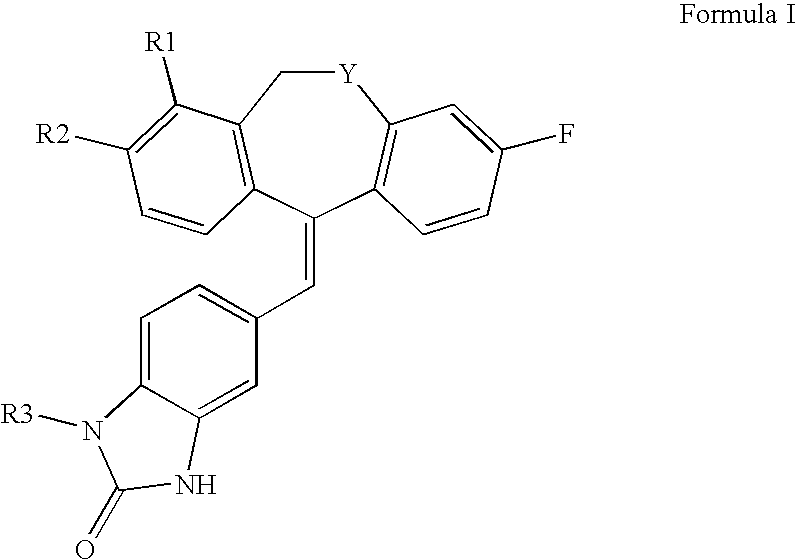Tricyclic steroid hormone nuclear receptor modulators
a technology of nuclear receptor and steroid hormone, which is applied in the field of tricyclic steroid hormone nuclear receptor modulators, can solve the problems of increased melanin pigmentation of the skin, increased muscle weakness, and increased blood pressure, and achieves increased sodium retention, increased magnesium and potassium excretion, and increased water retention
- Summary
- Abstract
- Description
- Claims
- Application Information
AI Technical Summary
Benefits of technology
Problems solved by technology
Method used
Image
Examples
preparation 1
3-Fluoro-11-methylene-6,11-dihydro-dibenzo[b,e]oxepine
[0184]
[0185]Cool a solution of 3-fluoro-6H-dibenzo[b,e]oxepin-11-one (prepared according to the procedure reported by M Kurokawa, F Sato, Y Masuda, T Yoshida and Y Ochi, Chem. Pharm. Bull., 1991, 39(10), 2564-5273; 11.5 g, 50.5 mmol) and THF (100 mL) to 0° C. under N2. Add dropwise MeMgBr (3.0M in Et2O, 33.7 mL, 101 mmol) this mixture. Warm to room temperature and stir overnight. Cool to 0° C. and quench very carefully (exotherm) with HCl (4.00 M in dioxane, 30 mL). Warm to room temperature and stir for 30 min. Dilute reaction mixture with water (70 mL) and extract into ethyl acetate (three 100 mL portions). Dry (MgSO4), filter, and concentrate organics to a brown solid. Purify crude product on a 100 g plug of silica gel, eluting with hexanes to afford 9.26 g (81%) of the title compound as a yellow solid. MS [EI] 226; HPLC shows 90% purity.
preparation 2
11-Bromomethylene-3-fluoro-6,11-dihydro-dibenzo[b,e]oxepine
[0186]
[0187]Dissolve 3-fluoro-11-methylene-6,11-dihydro-dibenzo[b,e]oxepine (8.23 g, 36.4 mmol) in CH2Cl2 (200 mL), then add DMAP.HBr3 (15.8 g, 43.7 mmol). Once DMAP.HBr3 has dissolved, quench excess bromine with saturated aqueous Na2SO3 (50 mL). Dilute with water (50 mL) and extract with CH2Cl2 (three 10 mL portions). Dry (MgSO4), filter, and concentrate organics to afford a yellow solid. Recrystallize from warm MeOH (200 mL) to afford a 97:3 E / Z mixture (HPLC) of the title compound. MS [EI] 304, 306.
preparation 3
2-(4-Bromo-2-nitro-phenylamino)-2-methyl-propan-1-ol
[0188]
[0189]As shown in Scheme ??, mix 5-bromo-2-fluoronitrobenzene (11.2 g, 50.5 mmol) and 2-amino-2-methyl-1-propanol (10.5 mL, 110 mmol) in THF (120 mL). Heat at reflux for 48 h and then cool to room temperature. Remove most of the THF under reduced pressure and then partition the residue between water and EtOAc. Wash the organic layer a second time with water and the dry (MgSO4) and concentrate to give an orange solid. Triturate the solid with hexane (200 mL) and dry to yield 12.95 g (89%) title compound. MS (es) 288 (M−1). HPLC (ISO80-10M) t=2.67 (100%).
PUM
| Property | Measurement | Unit |
|---|---|---|
| temperature | aaaaa | aaaaa |
| temperature | aaaaa | aaaaa |
| pressure | aaaaa | aaaaa |
Abstract
Description
Claims
Application Information
 Login to View More
Login to View More - R&D
- Intellectual Property
- Life Sciences
- Materials
- Tech Scout
- Unparalleled Data Quality
- Higher Quality Content
- 60% Fewer Hallucinations
Browse by: Latest US Patents, China's latest patents, Technical Efficacy Thesaurus, Application Domain, Technology Topic, Popular Technical Reports.
© 2025 PatSnap. All rights reserved.Legal|Privacy policy|Modern Slavery Act Transparency Statement|Sitemap|About US| Contact US: help@patsnap.com



